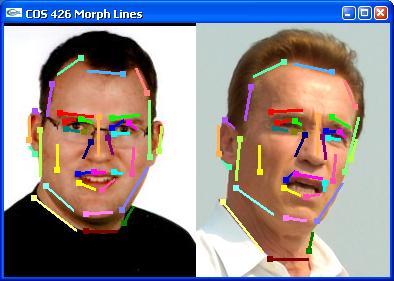We provide an interactive program (morphlines) that should help you specify these line correspondences between image pairs. You can download an executable for Windows, Mac OS X or you can download the source code and compile it yourself, which is the suggested method for Linux operating systems. When compiling the code, you will need the GLUT libraries; under Ubuntu, you can install them by typing
sudo apt-get install glutg3-dev
on the command line.
In any case, the program provides a simple interface
that lets you click points in the two images to specify pairs of
lines and then lets you save these line correspondences to a
text file that can be loaded within the body of your main
program (see the function imgpro.cpp::ReadCorrespondences()).
A screenshot of the correspondence editor is shown below.
Each line in the left image has an associated line in the
right image (colors indicate correspondences, and dots indicate
the start of the line segment-- since orientation is important).
This set of lines shown in this example is available
here.
It will define the correspondence used as input for a Beier-Neely
morph between these two images. 
(image of Arnold Schwarzenegger is credited to Jim Greenhill, Wikipedia)
morphlines.exe image1.jpg image2.jpg output_correspondences.txt [-input_correspondences initial_correspondences.txt]When the program starts up, you will see the first image on the left, and the second image on the right. The images are shown at their original sizes, and so you should not use images that cumulatively are bigger than your screen (the program will probably abort with an ugly error).
You can create lines by dragging the cursor with the left mouse button down. Lines are colored by the order they were created (per image), and so lines with the same color are in correspondence (however, note that there are only 24 colors and so they are re-used after a while). You can delete the last line by hitting the 'd' key or Delete key. This operates like an `undo' command -- if you don't like the last line you created, simply delete it and draw it again.
You exit the program by hitting the `q`key or the `ESC' key. It is important that you exit the program this way (rather than simplying closing the window) because then the lines you created will be saved to the filename that you gave on the command line. You can also save your lines at any time during execution of the program by hitting the 's' key.
Should you encounter any problems/bugs with this application please post them on Piazza.
- Drag left mouse button -- create line
- 'd' or Delete key -- delete last line
- 'q' or Esc key -- save lines to file and exit
- 's' key -- save lines to file and continue